The Effect of Ion Irradiation Density on the Defect of Graphene: A Molecular Dynamics Study
Abstract
1. Introduction
2. Materials and Methods
3. Results and Discussion
3.1. Suspended Single-Layer Graphene
3.2. Single-Layer Graphene on Copper Substrate
3.3. Bi-Layer Graphene on Copper Substrate
4. Conclusions
Author Contributions
Funding
Conflicts of Interest
References
- Meyer, J.C.; Geim, A.K.; Katsnelson, M.I.; Novoselov, K.S.; Booth, T.J.; Roth, S. The structure of suspended graphene sheets. Nature 2007, 446, 60–63. [Google Scholar] [CrossRef]
- Neto, A.H.C.; Guinea, F.; Peres, N.M.R.; Novoselov, K.S.; Geim, A.K. The electronic properties of graphene. Rev. Mod. Phys. 2009, 81, 109–162. [Google Scholar] [CrossRef]
- Qin, H.; Sun, J.; Liang, S.; Li, X.; Yang, X.; He, Z.; Yu, C.; Feng, Z. Room-temperature, low-impedance and high-sensitivity terahertz direct detector based on bilayer graphene field-effect transistor. Carbon 2017, 116, 760–765. [Google Scholar] [CrossRef]
- Geim, A.K.; Novoselov, K.S. The rise of graphene. Nat. Mater. 2007, 6, 183–191. [Google Scholar] [CrossRef]
- Sasaki, K. Phonon anomaly by massive Dirac fermions of graphene. Phys. Rev. B 2018, 97, 155413. [Google Scholar] [CrossRef]
- Peimyoo, N.; Yu, T.; Shang, J.; Cong, C.; Yang, H. Thickness-dependent azobenzene doping in mono- and few-layer graphene. Carbon 2012, 50, 201–208. [Google Scholar] [CrossRef]
- Li, Y.; Zhou, Z.; Shen, P.; Chen, Z. Spin gapless semiconductor-metal-half-metal properties in nitrogen-doped zigzag graphene nanoribbons. ACS Nano 2009, 3, 1952–1958. [Google Scholar] [CrossRef]
- Yakubu, A.; Sani, G.D.; Abbas, Z. Graphene Synthesis by Chemical Vapour Deposition (CVD): A Review on Growth Mechanism and Techniques. Int. J. Eng. Res. 2019, 8, 15–26. [Google Scholar]
- Lehtinen, O.; Kotakoski, J.; Krasheninnikov, A.V.; Tolvanen, A.; Nordlund, K.; Keinonen, J. Effects of ion bombardment on a two-dimensional target: Atomistic simulations of graphene irradiation. Phys. Rev. B 2010, 81, 153401. [Google Scholar] [CrossRef]
- Choubak, S.; Levesque, P.L.; Gaufres, E.; Biron, M.; Desjardins, P.; Martel, R. Graphene CVD: Interplay Between Growth and Etching on Morphology and Stacking by Hydrogen and Oxidizing Impurities. Phys. Chem. C 2014, 118, 21532–21540. [Google Scholar] [CrossRef]
- Krasheninnikov, A.V.; Banhart, F. Engineering of nanostructured carbon materials with electron or ion beams. Nat. Mater. 2007, 6, 723–733. [Google Scholar] [CrossRef]
- Kwieciñski, W.; Kai, S.; Poelsema, B.; Zandvliet, H.J.W.; Bampoulis, P. Chemical vapor deposition growth of bilayer graphene in between molybdenum disulfide sheets. J. Colloid Interface Sci. 2017, 505, 776–782. [Google Scholar] [CrossRef]
- Liang, Z.; Xu, Z.; Yan, T.; Ding, F. Atomistic simulation and the mechanism of graphene amorphization under electron irradiation. Nanoscale 2014, 6, 2082. [Google Scholar] [CrossRef]
- Lucchese, M.M.; Stavale, F.; Ferreira, E.H.M.; Vilani, C.; Moutinho, M.V.O.; Capaz, R.B.; Achete, C.A.; Jorio, A. Quantifying ion-induced defects and Raman relaxation length in graphene. Carbon 2010, 48, 1592–1597. [Google Scholar] [CrossRef]
- Li, W.; Wang, X.; Zhang, X.; Zhao, S.; Duan, H.; Xue, J. Mechanism of the defect formation in supported graphene by energetic heavy ion irradiation: The substrate effect. Sci. Rep. 2015, 5, 9935. [Google Scholar] [CrossRef]
- Zeng, J.; Yao, H.J.; Zhang, S.X.; Zhai, P.F.; Duan, J.L.; Sun, Y.M. Swift heavy ions induced irradiation effects in monolayer graphene and highly oriented pyrolytic graphite. Nucl. Instrum. Methods Phys. Res. Sect. B Beam Interact. Mater. At. 2014, 330, 18–23. [Google Scholar] [CrossRef]
- Zhao, S.; Xue, J.; Wang, Y.; Yan, S. Effect of SiO2 Substrate on the irradiation-assisted manipulation of supported graphene: A molecular dynamics study. Nanotechnology 2012, 23, 285703. [Google Scholar] [CrossRef]
- Zhao, D.; Wang, Q.; Ding, J. Physical mechanism of swift heavy ion irradiation effect in graphene. Radiat. Eff. Defects Solids 2019, 174, 617–623. [Google Scholar] [CrossRef]
- Zhao, D. Multiscale Simulations of Irradiation Effects of Bilayer Graphene Induced by Swift Heavy Ions. J. Comput. Theor. Nanosci. 2017, 14, 485–489. [Google Scholar] [CrossRef]
- Nebogatikova, N.A.; Antonova, I.V.; Erohin, S.V.; Krasheninnikov, A.V. Nanostructuring few-layer graphene films by swift heavy ions for electronic application: Tuning of electronic and transport properties. Nanoscale 2018, 10, 14499–14509. [Google Scholar] [CrossRef]
- Liao, W.; Alles, M.; Zhang, E.X. Monte Carlo Simulation of Displacement Damage in Graphene. IEEE Trans. Nucl. Sci. 2019, 66, 1730–1737. [Google Scholar] [CrossRef]
- Vazquez, H.; Ahlgren, E.H.; Ochedowski, O.; Krasheninnikov, A.V. Creating nanoporous graphene with swift heavy ions. Carbon 2017, 114, 511–518. [Google Scholar] [CrossRef]
- Car, R.; Parrinello, M. Unified Approach for Molecular Dynamics and Density-Functional Theory. Phys. Rev. Lett. 1985, 55, 2471–2474. [Google Scholar] [CrossRef]
- Saito, R.; Fujita, M.; Dresselhaus, G.; Dresselhaus, M.S. Electronic structure of chiral graphene tubules. Appl. Phys. Lett. 1992, 60, 2204–2206. [Google Scholar] [CrossRef]
- Jiang, J.W.; Wang, J.S.; Li, B. Young’s modulus of graphene: A molecular dynamics study. Phys. Rev. B 2009, 80, 113405. [Google Scholar] [CrossRef]
- Stuart, S.J.; Tutein, A.B.; Harrison, J.A. A reactive potential for hydrocarbons with intermolecular interactions. J. Chem. Phys. 2000, 112, 6472–6486. [Google Scholar] [CrossRef]
- Wu, X.; Zhao, H.; Zhong, M. Molecular dynamics simulation of graphene sheets joining under ion beam irradiation. Carbon 2014, 66, 31–38. [Google Scholar] [CrossRef]
- Ong, Z.Y.; Pop, E. Molecular dynamics simulation of thermal boundary conductance between carbon nanotubes and SiO2. Phys. Rev. B 2010, 81, 155408. [Google Scholar] [CrossRef]
- Favata, A.; Micheletti, A.; Podio-Guidugli, P.; Pugno, N. Geometry and Self-stress of Single-Wall Carbon Nanotubes and Graphene via a Discrete Model Based on a 2nd-Generation REBO Potential. J. Elast. 2016, 125, 1–37. [Google Scholar] [CrossRef]
- Banhart, F.; Kotakoski, J.; Krasheninnikov, A.V. Structural defects in graphene. ACS Nano 2011, 5, 26–41. [Google Scholar] [CrossRef]
- Boukhvalov, D.W.; Katsnelson, M.I. Chemical Functionalization of Graphene with Defects. Nano Lett. 2008, 8, 4373–4379. [Google Scholar] [CrossRef]
- Kotakoski, J.; Krasheninnikov, A.V.; Kaiser, U.; Meyer, J. From point defects in graphene to two-dimensional amorphous carbon. Physrevlett 2011, 106, 105505. [Google Scholar] [CrossRef]
- Wang, S.; Zhang, Q.; Yin, K.; Gao, B.; Zhang, S.; Wang, G.; Liu, H. The Influence of Copper Substrates on Irradiation Effects of Graphene: A Molecular Dynamics Study. Materials 2019, 12, 319. [Google Scholar] [CrossRef]
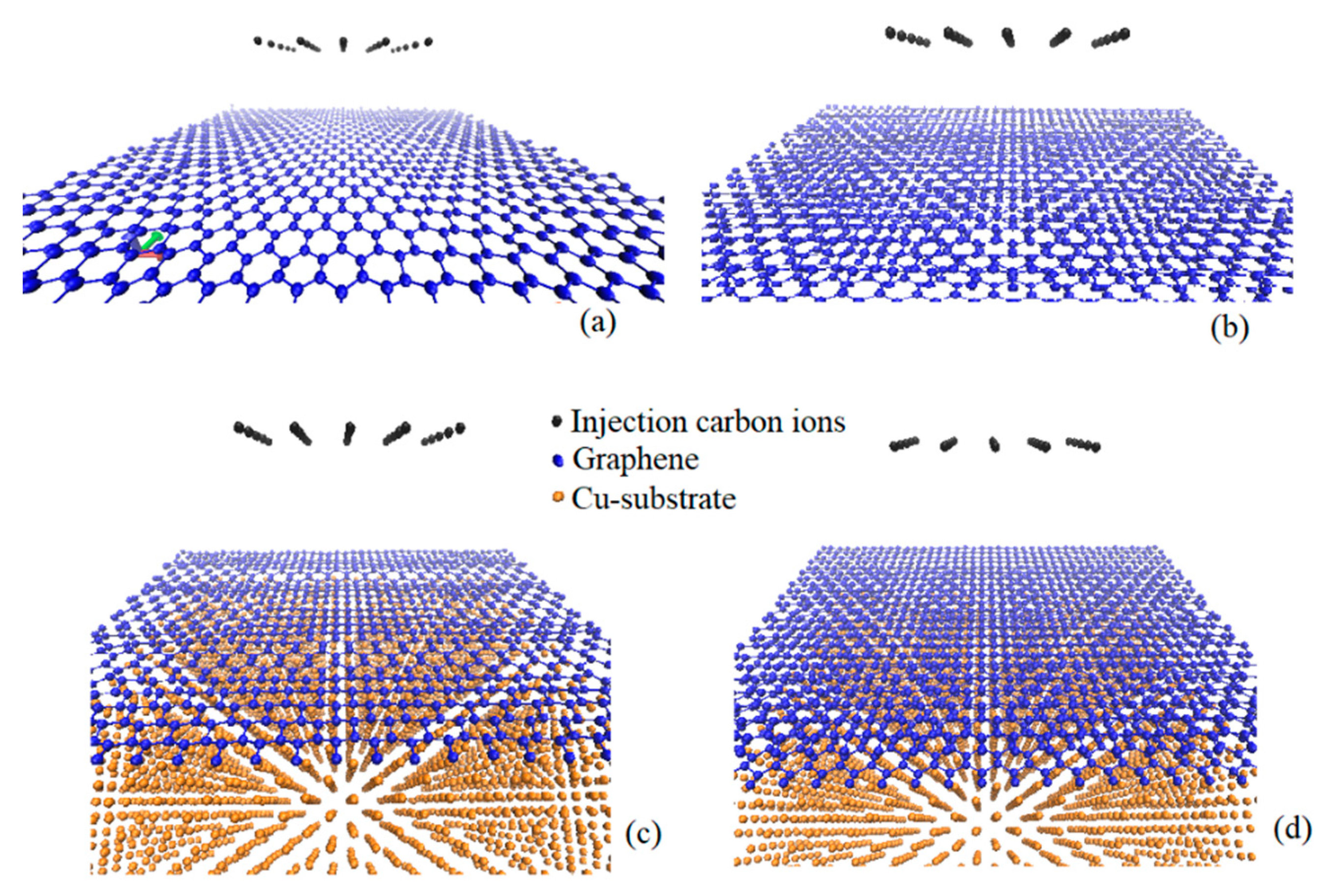

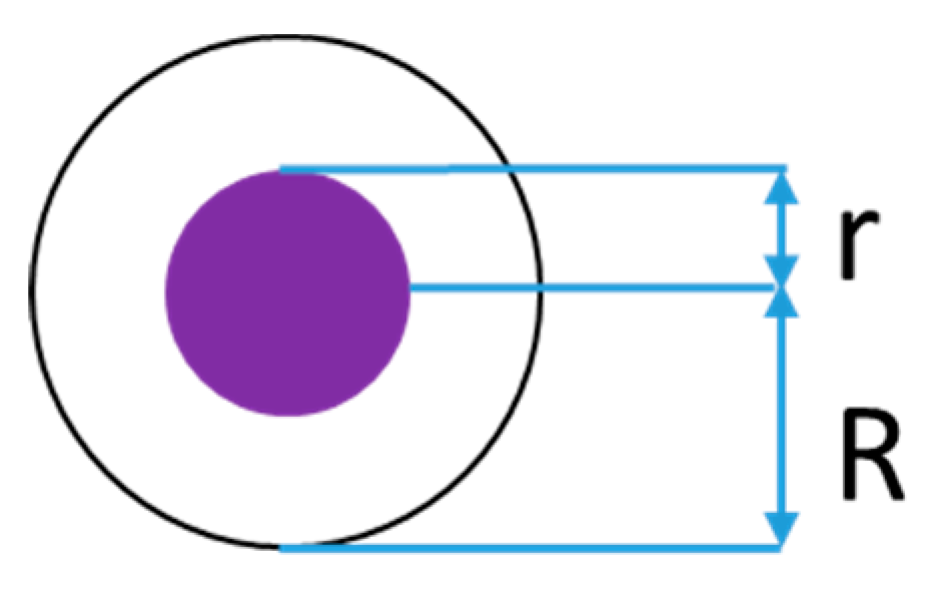

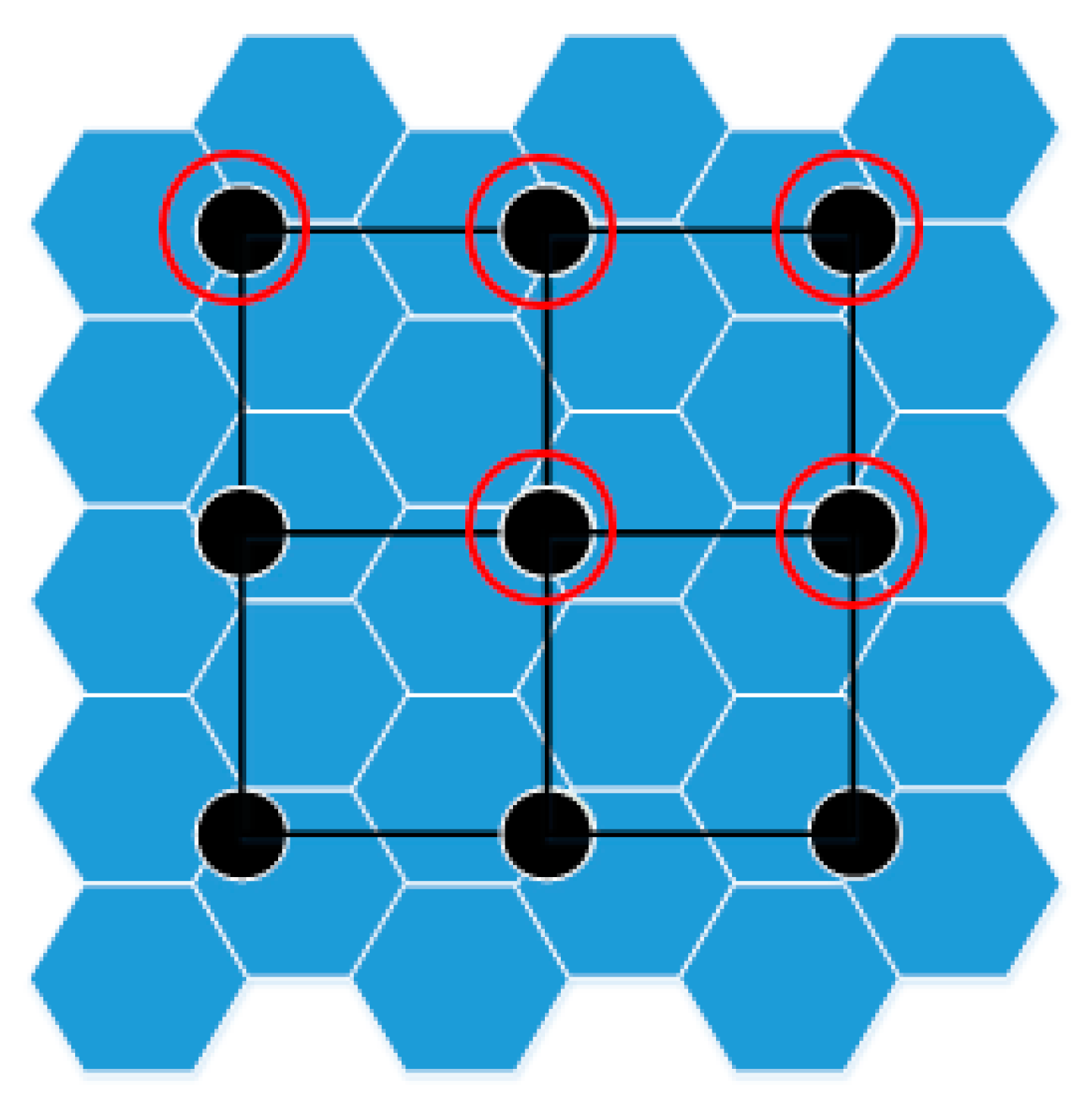
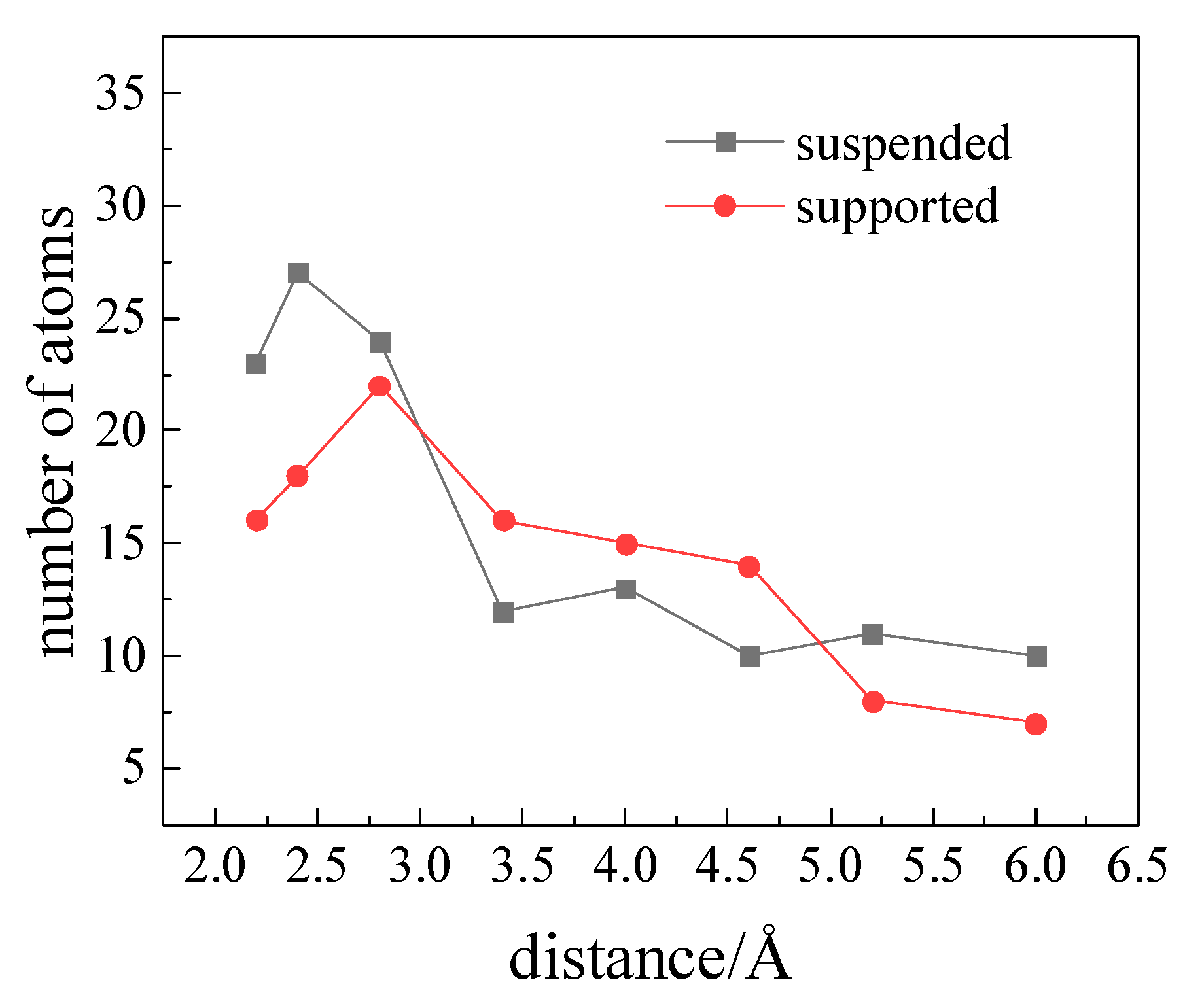
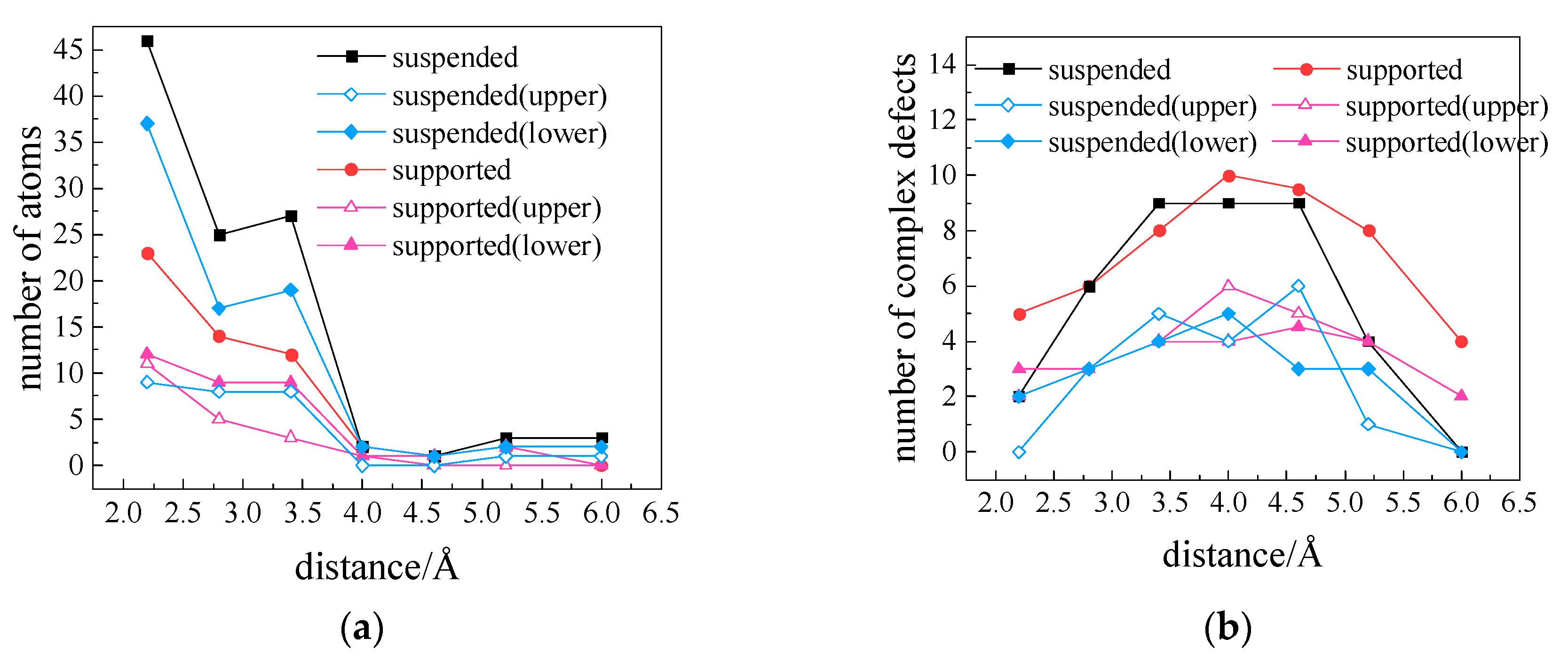
| Irradiation Energy/keV | R/Å | r/Å | (R + r)/Å |
|---|---|---|---|
| 0.87 | 3 | 0.75 | 3.75 |
| 1.96 | 2.4 | 0.67 | 3.07 |
| 4.41 | 1.8 | 0.6 | 2.4 |
© 2020 by the authors. Licensee MDPI, Basel, Switzerland. This article is an open access article distributed under the terms and conditions of the Creative Commons Attribution (CC BY) license (http://creativecommons.org/licenses/by/4.0/).
Share and Cite
Lin, J.; Wang, S.; Liu, H.; Yin, K.; Wu, L.; Li, W. The Effect of Ion Irradiation Density on the Defect of Graphene: A Molecular Dynamics Study. Crystals 2020, 10, 158. https://doi.org/10.3390/cryst10030158
Lin J, Wang S, Liu H, Yin K, Wu L, Li W. The Effect of Ion Irradiation Density on the Defect of Graphene: A Molecular Dynamics Study. Crystals. 2020; 10(3):158. https://doi.org/10.3390/cryst10030158
Chicago/Turabian StyleLin, Jinfu, Shulong Wang, Hongxia Liu, Kai Yin, Lei Wu, and Wei Li. 2020. "The Effect of Ion Irradiation Density on the Defect of Graphene: A Molecular Dynamics Study" Crystals 10, no. 3: 158. https://doi.org/10.3390/cryst10030158
APA StyleLin, J., Wang, S., Liu, H., Yin, K., Wu, L., & Li, W. (2020). The Effect of Ion Irradiation Density on the Defect of Graphene: A Molecular Dynamics Study. Crystals, 10(3), 158. https://doi.org/10.3390/cryst10030158








